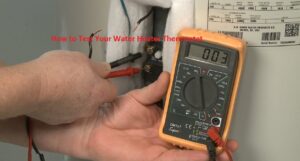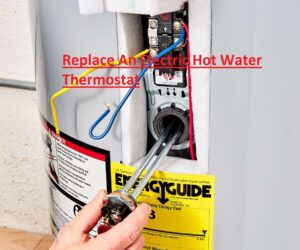 Hello readers welcome to the new post. In this post, we will have a look at How to Test Your Water Heater Thermostat. It can be time to check the thermostat if the water heater is not working well. Improper warming, leakage, and water heater damage can casues malfunctioning thermostats.
Hello readers welcome to the new post. In this post, we will have a look at How to Test Your Water Heater Thermostat. It can be time to check the thermostat if the water heater is not working well. Improper warming, leakage, and water heater damage can casues malfunctioning thermostats.
In this post, we will cover details that will help us to test and replace the electric hot water thermostat. Testing your water heater thermostat is not difficult. So let’s get started How to Test Your Water Heater Thermostat
Testing Electric Water Heater Thermostats
- Ensure that there is proper equipment set before starting to check the water heater thermostat. The voltage detector screwdriver and multimeter are used. The methods are explained here.
Procedure For Testing A Hot Water Thermostat
- Starting with turning off the power supply of the heater. We can off the breaker that manages the water heater if not know how to do it further.
- Find a water heater thermostat cover. A thermostat cover exists on the side or top part of the water heater on the base of the model used.
- The screwdriver can be used to remove the screw holding the lid on. For opening the thermostat remove the lid.
- Slant the cutout flap for thermostat removal. At the lower of the thermostat cover, where cut-out flap is configured.
- To get the terminal remove the thermostat plastic covering
- Set the multimeter at resistance value. adjust the ohm setting on the meter.
- Check the reset button of the thermostat. For resetting the thermostat push the button if it is out of pushed
- To test the accuracy of the thermostat remove the power supply
- Connect the meter with the upper reset point of the thermostat. get a note of the meter reading when connecting 2nd lead with the terminal on the left. Note the reading of meter and connected 2nd lead with terminals on the right
- At upper and lower pins of water heat must be connected to the multimeter. Attach 2nd lead with higher terminals and record meter reading. Ensure meter reading after connecting leads with the bottom hearing component. Check that the water is hot or cool
- Connect the meter with terminals at the low thermostat for testing it. The multimer should show zero ohms if the thermostat is operating accurately
- Using data from mere it can check whether thermostat has been set or not
How to Replace An Electric Hot Water Thermostat
- Here are some steps explained that will be helpful in replacing the thermostat
- Off the power supply and breaker also off
- Remove insulation of water heaters and outer access panel
- Screw the defective thermostat out of the water heater
- The replacement thermostat must be put and secured with a screw at the same point as the older
- Set the required temperature on the new thermostat
- Vary access panels on the outer side and insulation

Procedure For Testing A Hot Water Thermostat
- First off all thermostats must be off from the power supply of the water heater. Find an off breaker that also provdies power to the heater. it helps to protect devices during working
- The home electrical panel must have a water heater circuit breaker. The water heater is connected to the breaker so find and flip it off
- The electric water heater thermostat is connected behind a panel on the tank side. For accessing panel we can reach the panel and need to remove some screws based on brand and heater
- Remove the cover of the thermostat and use of driver
- The cutout flap is seen when the cover is removed. To find thermostat tilt it
- To get the terminal screwd to remove the plastic covering from the thermostat
- On the meter select the continuity test setting.
- Find the thermostat reset button. For checking if it clicks press it. It will check when it operating accurately
- Unplug the thermostat power supply cables
- Connect the meter with the thermostat reset terminal. The 2nd leads of the terminal must be connected on the left. Note the reading that gets from the meter.2dn leads with terminals must be connected to the right. Note that the meter reading
- Reconnect the thermostat of the meter.2nd lead must be connected with the upper terminal. Note meter reading. Lead must be connected to the lowest heating component. check the reading of the meter. note if the water is hot or cool.
- Must carry same press on the lower thermostat to check it
- You have to get the idea if thermostats if operating accurately after performing tests. it is damaged there is need to replace it.If need further help get the services of plumber.
How do I know if My Water Heater Thermostat is Bad?
If the water heater is not making warm water or the temperature after is not consistent it means the thermostat is not operating well.. So we must check the thermostat to make sure that it is broken before deciding on any results. if a meter is used to test the thermostat and the result is faulty it must be changed
How do you Fix a Water Heater Thermostat?
- Off the water heater power source
- To reach the thermostat, remove the insulation and exterior access panel.
- Note the wiring configuration at the thermostat and snap a photo for future reference.
- From the bracket, remove the old thermostat.
- The wires must be connected in the same method as the older module connected and the new device must be placed in a bracket
- Set the desired temperature on the new thermostat.
- Change the access panel and insulation.
- Make sure the water heater is functioning properly before turning on the electricity.
What Happens When a Water Heater Thermostat Goes Out?
if the thermostat goes out in a single-element heater it will not produce hot water. Two-element water heaters have thermostats for each element. The upper thermostat is used for two uses fist it contains the upper element on top of the tank.
FAQs:
Write common problems with water heaters.
- it main issue is that gets rust-colored water, unpleasant odor water leaks, and odd noises.
Is there a universal electric water heater thermostat?
- NO there is no thermostat for the electric water heater. There are differnt thermostats so make sure to get accurate for uses
What causes a hot water heater thermostat to fail?
- Wear and tear, aging, and electrical problems are causes of hot water heater thermostat failure.
Why is my water heater always shutting down?
- A broken thermostat, a defective heating element, or sediment in tank are a possible causes of a water heater switching off. To avoid more damage or the unit’s full failure, it’s important to find the casues and fix them as soon as feasible.
Conclusion:
It’s easy to test the water heater thermostat, which saves our money and time and avoids any extra preparing. With using details given above make sure the heater functioning properly and efficiently. it can make sure water heater provdies required hot water for many years by taking proper care of it.






Whoa! I had no idea there were so many types of water heater thermostats. This blog really breaks it down in an easy-to-understand way. Thanks for sharing this valuable info with us!